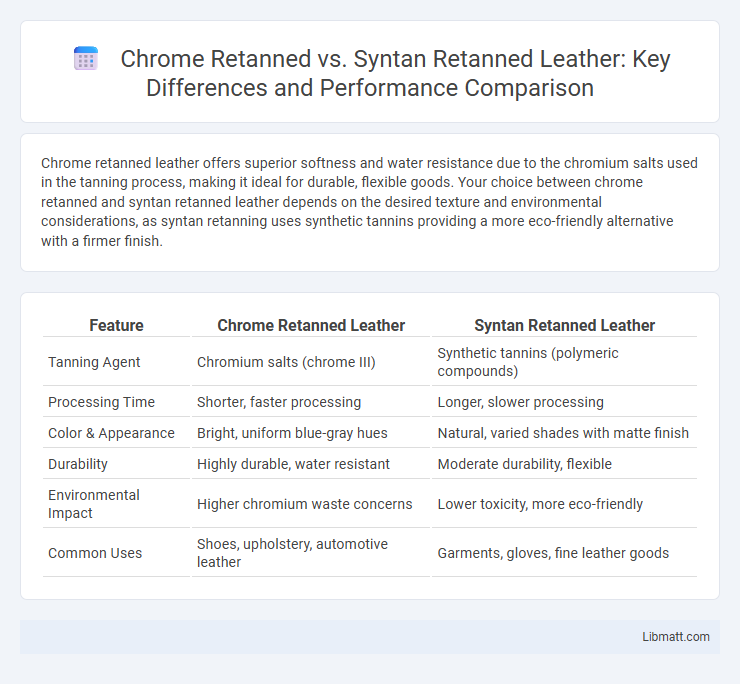Chrome retanned leather offers superior softness and water resistance due to the chromium salts used in the tanning process, making it ideal for durable, flexible goods. Your choice between chrome retanned and syntan retanned leather depends on the desired texture and environmental considerations, as syntan retanning uses synthetic tannins providing a more eco-friendly alternative with a firmer finish.
Table of Comparison
| Feature | Chrome Retanned Leather | Syntan Retanned Leather |
|---|---|---|
| Tanning Agent | Chromium salts (chrome III) | Synthetic tannins (polymeric compounds) |
| Processing Time | Shorter, faster processing | Longer, slower processing |
| Color & Appearance | Bright, uniform blue-gray hues | Natural, varied shades with matte finish |
| Durability | Highly durable, water resistant | Moderate durability, flexible |
| Environmental Impact | Higher chromium waste concerns | Lower toxicity, more eco-friendly |
| Common Uses | Shoes, upholstery, automotive leather | Garments, gloves, fine leather goods |
Introduction to Leather Retanning Processes
Chrome retanned leather undergoes treatment with chromium salts, enhancing its softness, water resistance, and durability, making it ideal for upholstery and automotive applications. Syntan retanning uses synthetic tanning agents, providing better color uniformity, environmental benefits, and more versatility in finished leather characteristics. Understanding these differences helps you choose the right leather treatment based on desired texture, performance, and environmental considerations.
What is Chrome Retanning?
Chrome retanning is a leather processing technique that uses chromium salts, primarily chromium III, to enhance leather properties such as softness, water resistance, and durability. This method improves the leather's stability and color uniformity, making it suitable for high-quality footwear, upholstery, and automotive interiors. Chrome retanned leather exhibits superior heat resistance and maintains flexibility over time compared to syntan retanned leather.
What is Syntan Retanning?
Syntan retanning involves the use of synthetic tanning agents derived from phenol, naphthalene, or sulfonic acid compounds to enhance leather properties such as softness, fullness, and water resistance. Unlike chrome retanning, which utilizes chromium salts for faster processing and improved heat resistance, syntan retanning offers more environmentally friendly options with tailored modifications to color and texture. This method is often combined with chrome retanning to optimize leather durability and aesthetic appeal in various industries.
Key Differences Between Chrome and Syntan Retanning
Chrome retanned leather utilizes chromium salts during the retanning process, providing superior water resistance, softness, and thermal stability, making it ideal for automotive and apparel applications. Syntan retanning employs synthetic tanning agents such as phenolic and acrylic polymers, resulting in enhanced lightfastness, deeper color penetration, and environmentally friendlier processing compared to chrome retanning. The distinct chemical bases influence the leather's physical properties, environmental impact, and suitability for specific end-uses, with chrome offering durability and syntan favoring ecological considerations.
Advantages of Chrome Retanned Leather
Chrome retanned leather offers enhanced durability and superior resistance to water and heat compared to syntan retanned leather, making it ideal for products that require long-lasting performance. Its soft texture and excellent color retention provide a premium finish that maintains aesthetic appeal over time. You benefit from chrome retanned leather's flexibility and quicker tanning process, reducing production time while delivering consistent quality.
Benefits of Syntan Retanned Leather
Syntan retanned leather offers enhanced durability, consistent color retention, and improved resistance to environmental factors compared to chrome retanned leather. Its eco-friendly tanning agents reduce harmful chemical usage, making it a sustainable choice for leather products. You benefit from a more versatile and high-quality leather suitable for fashion, upholstery, and automotive applications.
Environmental Impact: Chrome vs Syntan Retanning
Chrome retanning involves heavy metals that pose significant environmental pollution risks through toxic wastewater and soil contamination. Syntan retanning uses synthetic organic chemicals with a lower ecological footprint, reducing hazardous waste and facilitating more sustainable leather production. Choosing syntan retanning can help your business minimize environmental impact while maintaining leather quality.
Leather Quality: Durability and Appearance Comparison
Chrome retanned leather features enhanced durability and resistance to water and stains due to the use of chromium salts, making it more suitable for high-wear applications with a consistent, smooth appearance. Syntan retanned leather employs synthetic tanning agents that improve grain uniformity and colorfastness, offering vibrant hues and a refined finish but may exhibit slightly less durability under harsh conditions. Both methods yield high-quality leather, yet chrome retanning excels in strength and longevity while syntan retanning prioritizes aesthetic refinement and environmental benefits.
Applications and End Uses of Each Retanning Method
Chrome retanned leather is extensively used in automotive upholstery, footwear, and fashion accessories due to its durability, water resistance, and soft texture, making it ideal for products requiring flexibility and quick production cycles. Syntan retanned leather finds applications in high-end furniture, bookbinding, and luxury leather goods where enhanced grain structure, uniform coloration, and environmental sustainability are prioritized. The choice between chrome and syntan retanning significantly impacts the leather's performance, appearance, and suitability for specific industry demands.
Choosing the Right Retanning Process for Your Needs
Chrome retanned leather offers superior water resistance, durability, and a softer feel, making it ideal for high-use items like footwear and upholstery. Syntan retanned leather provides excellent lightfastness and a natural appearance, preferred for fashion accessories and garments requiring a more eco-friendly finish. Your choice depends on the balance between durability, aesthetic preferences, and environmental considerations for your project.
Chrome retanned vs syntan retanned Infographic

 libmatt.com
libmatt.com